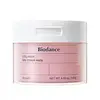What's inside
What's inside
 Key Ingredients
Key Ingredients

 Benefits
Benefits

 Concerns
Concerns

No concerns
 Ingredients Side-by-side
Ingredients Side-by-side

Water
Skin ConditioningGlycyrrhiza Uralensis Root Extract 15%
Skin ConditioningButylene Glycol
HumectantDipropylene Glycol
HumectantGlycerin
HumectantPropylene Glycol
HumectantHydroxyacetophenone
AntioxidantPolyglyceryl-10 Laurate
Skin ConditioningBetaine
HumectantCentella Asiatica Extract
CleansingAllantoin
Skin ConditioningCarbomer
Emulsion StabilisingEthylhexylglycerin
Skin ConditioningHydroxyethylcellulose
Emulsion StabilisingPolygonum Cuspidatum Root Extract
AntioxidantScutellaria Baicalensis Root Extract
AstringentAngelica Gigas Root Extract
Skin ConditioningMagnolia Kobus Branch/Flower/Leaf Extract
Skin ConditioningPrunus Mume Fruit Extract
HumectantRehmannia Chinensis Root Extract
Skin ConditioningCamellia Sinensis Leaf Extract
AntimicrobialDisodium EDTA
Glycyrrhiza Glabra Root Extract
BleachingChamomilla Recutita Flower Extract
MaskingPanthenol
Skin ConditioningRosmarinus Officinalis Leaf Extract
AntimicrobialArginine
MaskingAmyris Balsamifera Bark Oil
MaskingJuniperus Mexicana Oil
MaskingMelaleuca Alternifolia Leaf Oil
AntioxidantRosa Damascena Flower Oil
MaskingWater, Glycyrrhiza Uralensis Root Extract 15%, Butylene Glycol, Dipropylene Glycol, Glycerin, Propylene Glycol, Hydroxyacetophenone, Polyglyceryl-10 Laurate, Betaine, Centella Asiatica Extract, Allantoin, Carbomer, Ethylhexylglycerin, Hydroxyethylcellulose, Polygonum Cuspidatum Root Extract, Scutellaria Baicalensis Root Extract, Angelica Gigas Root Extract, Magnolia Kobus Branch/Flower/Leaf Extract, Prunus Mume Fruit Extract, Rehmannia Chinensis Root Extract, Camellia Sinensis Leaf Extract, Disodium EDTA, Glycyrrhiza Glabra Root Extract, Chamomilla Recutita Flower Extract, Panthenol, Rosmarinus Officinalis Leaf Extract, Arginine, Amyris Balsamifera Bark Oil, Juniperus Mexicana Oil, Melaleuca Alternifolia Leaf Oil, Rosa Damascena Flower Oil
Water
Skin ConditioningCollagen Water
HumectantButylene Glycol
Humectant1,2-Hexanediol
Skin ConditioningPolyglyceryl-10 Laurate
Skin ConditioningGlycerin
HumectantEthylhexylglycerin
Skin ConditioningArginine
MaskingAllantoin
Skin ConditioningCarbomer
Emulsion StabilisingXanthan Gum
EmulsifyingDisodium EDTA
Sodium Polyacrylate
AbsorbentCyanocobalamin
Skin ConditioningPalmitoyl Tripeptide-5
Skin ConditioningHydrolyzed Hyaluronic Acid
HumectantCollagen Extract
Skin ConditioningHydrolyzed Elastin
EmollientGalactomyces Ferment Filtrate
HumectantHyaluronic Acid
HumectantSh-Polypeptide-22
Skin ConditioningSh-Oligopeptide-1
Skin ConditioningSh-Polypeptide-1
Skin ConditioningSh-Oligopeptide-2
Skin ConditioningSh-Polypeptide-3
Skin ConditioningWater, Collagen Water, Butylene Glycol, 1,2-Hexanediol, Polyglyceryl-10 Laurate, Glycerin, Ethylhexylglycerin, Arginine, Allantoin, Carbomer, Xanthan Gum, Disodium EDTA, Sodium Polyacrylate, Cyanocobalamin, Palmitoyl Tripeptide-5, Hydrolyzed Hyaluronic Acid, Collagen Extract, Hydrolyzed Elastin, Galactomyces Ferment Filtrate, Hyaluronic Acid, Sh-Polypeptide-22, Sh-Oligopeptide-1, Sh-Polypeptide-1, Sh-Oligopeptide-2, Sh-Polypeptide-3
 Reviews
Reviews

Ingredients Explained
These ingredients are found in both products.
Ingredients higher up in an ingredient list are typically present in a larger amount.
Allantoin is a soothing ingredient known for its protective and moisturizingg properties. Because of this, it is often added to products with strong active ingredients.
Studies show higher concentrations of this ingredient can promote wound healing.
Though it can be derived from the comfrey plant, allantoin is produced synthetically for cosmetic products to ensure purity.
Learn more about AllantoinArginine is an amino acid that is important for human development. Your body uses is it to produce hair keratin and skin collagen.
As a cosmetic ingredient, Arginine has antioxidant properties and can also help repair damaged skin. This ingredient is derived either synthetically or from animals.
Arginine isn't fungal acne safe when used in the presence of other lipids (fats, fatty acids, oils, esters, etc). Oils and fats occur naturally within the skin, so take caution when using Arginine if you're prone to fungal acne.
Learn more about ArginineButylene Glycol (or BG) is used within cosmetic products for a few different reasons:
Overall, Butylene Glycol is a safe and well-rounded ingredient that works well with other ingredients.
Though this ingredient works well with most skin types, some people with sensitive skin may experience a reaction such as allergic rashes, closed comedones, or itchiness.
Learn more about Butylene GlycolCarbomer is a polymer of acrylic acid. Its main role is to create a gel consistency.
A high amount of carbomer can cause pilling or balling up of products. Don't worry, most products contain 1% or less of carbomer.
Disodium EDTA plays a role in making products more stable by aiding other preservatives.
It is a chelating agent, meaning it neutralizes metal ions that may be found in a product.
Disodium EDTA is a salt of edetic acid and is found to be safe in cosmetic ingredients.
Learn more about Disodium EDTAEthylhexylglycerin (we can't pronounce this either) is commonly used as a preservative and skin softener. It is derived from glyceryl.
You might see Ethylhexylglycerin often paired with other preservatives such as phenoxyethanol. Ethylhexylglycerin has been found to increase the effectiveness of these other preservatives.
Glycerin is already naturally found in your skin. It helps moisturize and protect your skin.
A study from 2016 found glycerin to be more effective as a humectant than AHAs and hyaluronic acid.
As a humectant, it helps the skin stay hydrated by pulling moisture to your skin. The low molecular weight of glycerin allows it to pull moisture into the deeper layers of your skin.
Hydrated skin improves your skin barrier; Your skin barrier helps protect against irritants and bacteria.
Glycerin has also been found to have antimicrobial and antiviral properties. Due to these properties, glycerin is often used in wound and burn treatments.
In cosmetics, glycerin is usually derived from plants such as soybean or palm. However, it can also be sourced from animals, such as tallow or animal fat.
This ingredient is organic, colorless, odorless, and non-toxic.
Glycerin is the name for this ingredient in American English. British English uses Glycerol/Glycerine.
Learn more about GlycerinPolyglyceryl-10 Laurate is an ester of lauric acid and Polyglycerin-10.
Polyglyceryl-10 Laurate is a cleansing agent and emulsifier. It helps gather dirt, oil, and other pollutants to be rinsed away. As an emulsifier, it helps prevent ingredients from separating, such as oil and water.
Polyglyceryl-10 Laurate may not be fungal acne safe.
Learn more about Polyglyceryl-10 LaurateWater. It's the most common cosmetic ingredient of all. You'll usually see it at the top of ingredient lists, meaning that it makes up the largest part of the product.
So why is it so popular? Water most often acts as a solvent - this means that it helps dissolve other ingredients into the formulation.
You'll also recognize water as that liquid we all need to stay alive. If you see this, drink a glass of water. Stay hydrated!
Learn more about Water